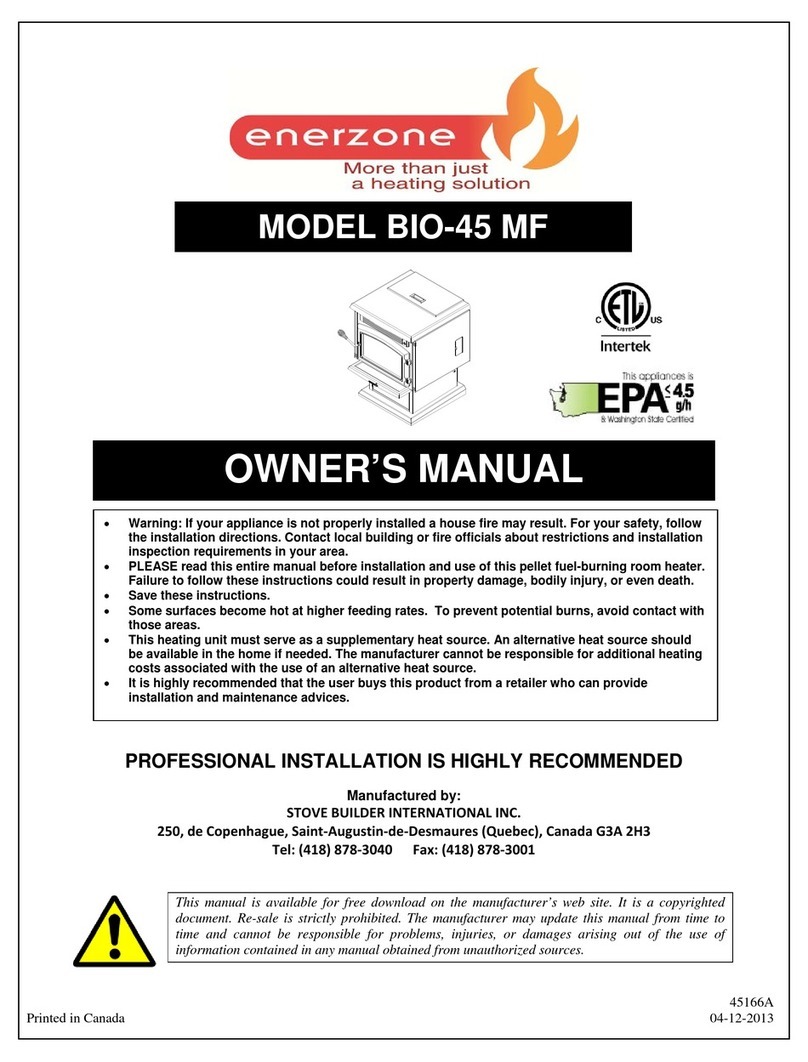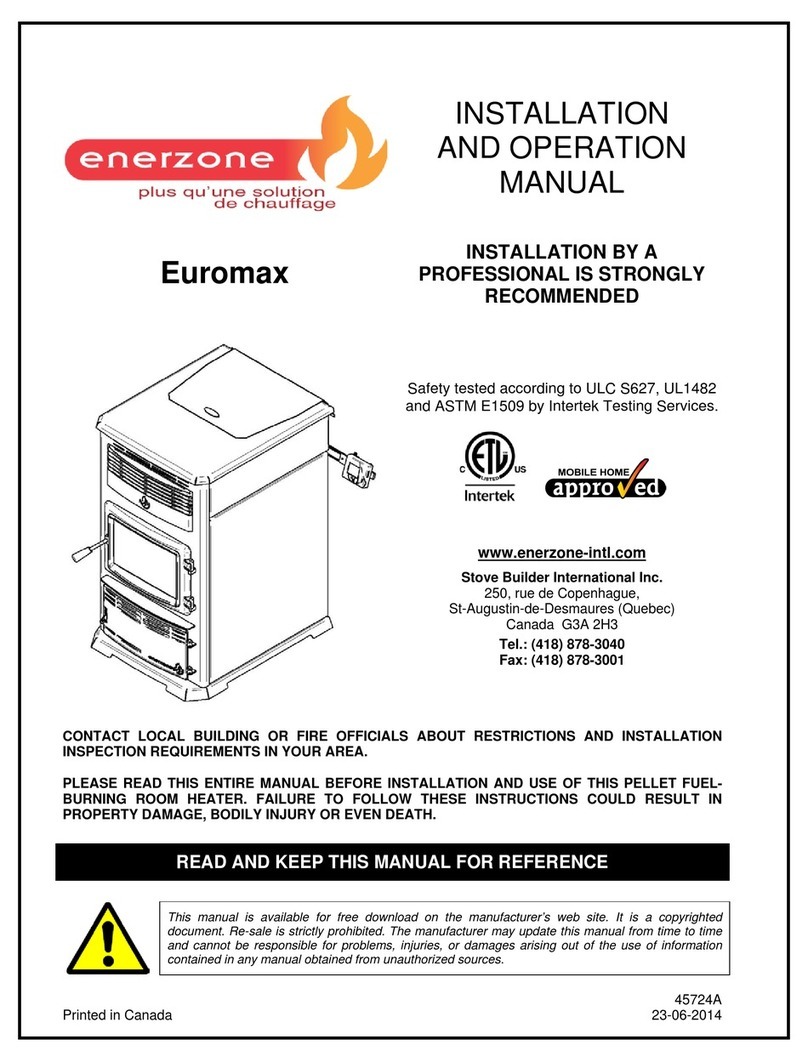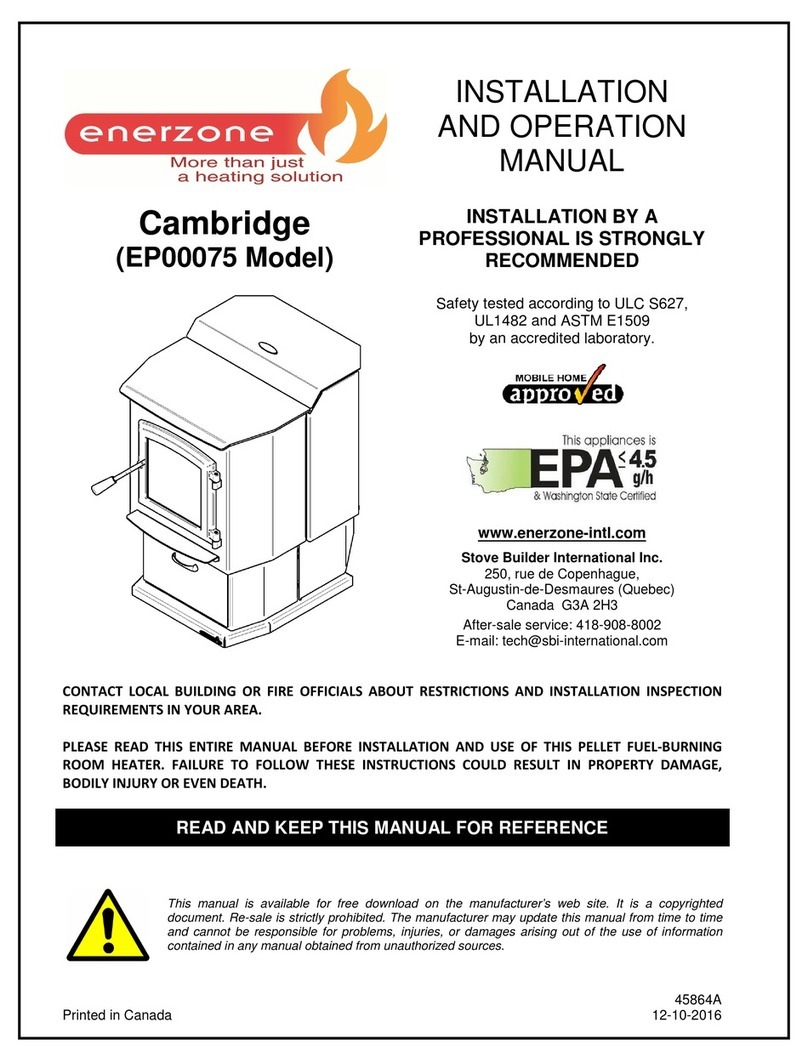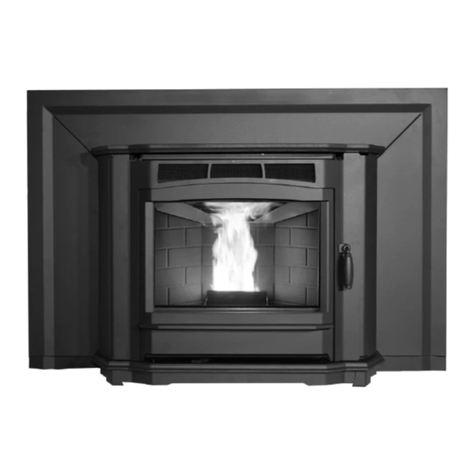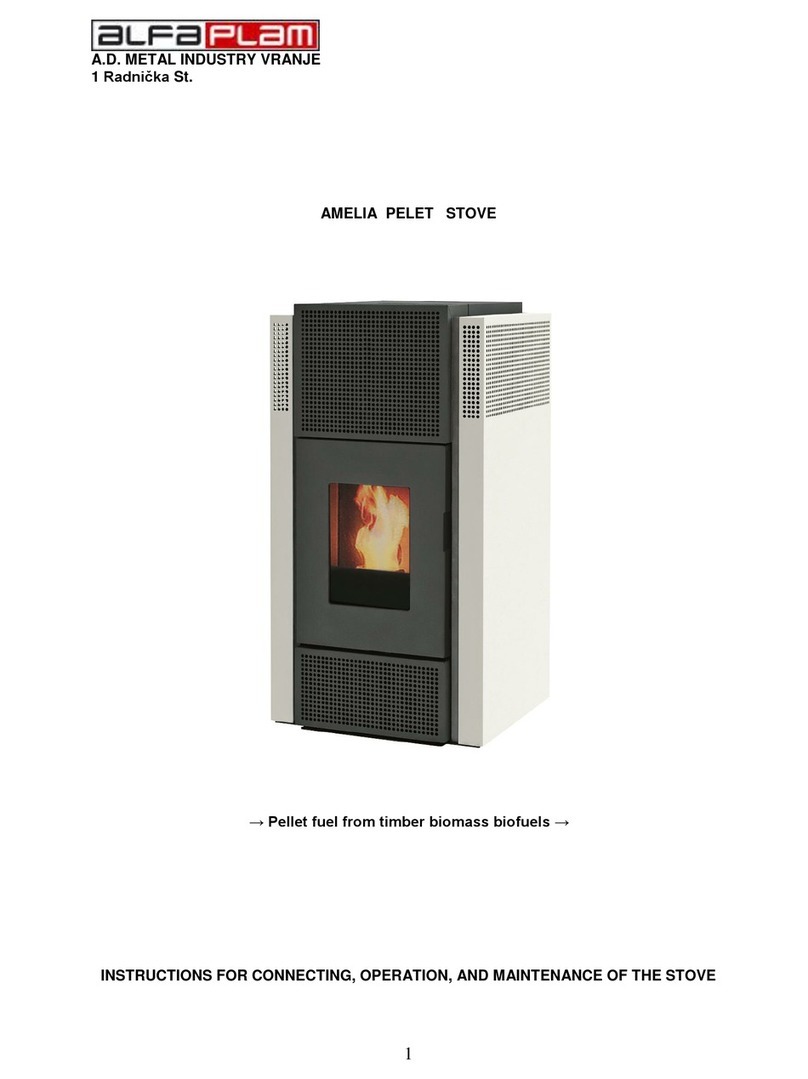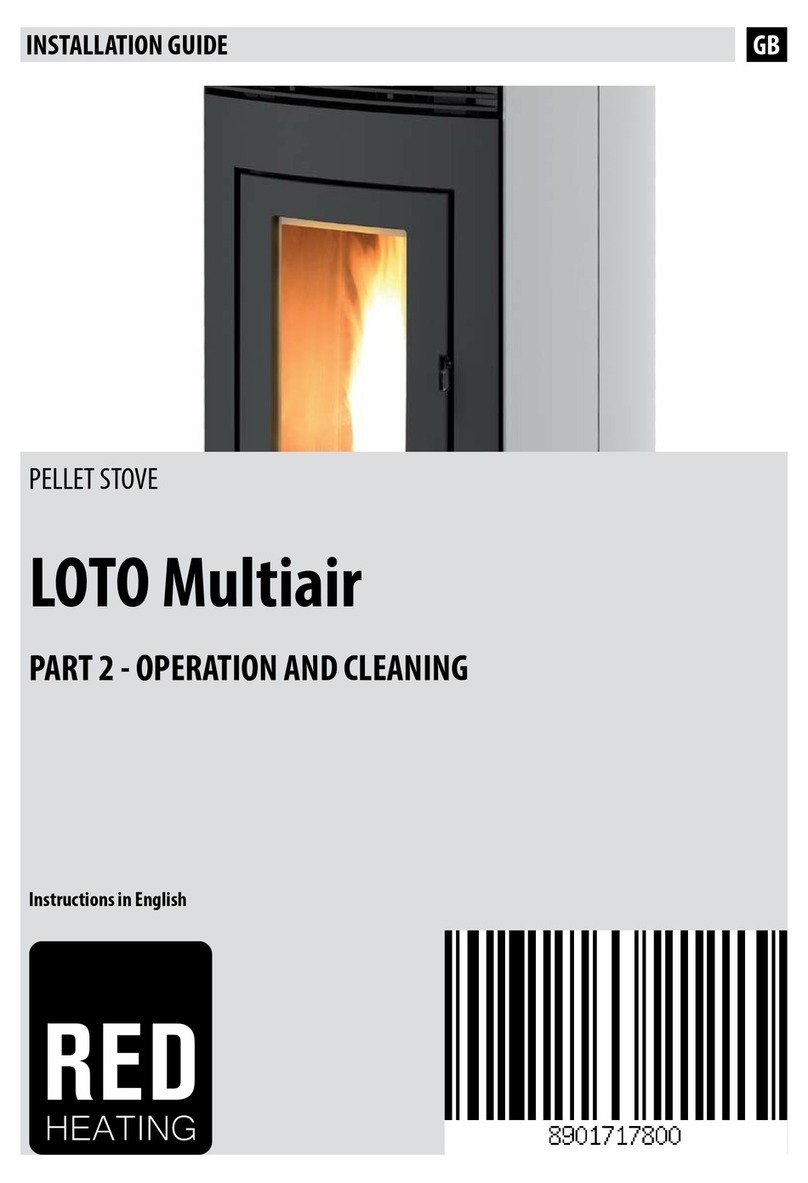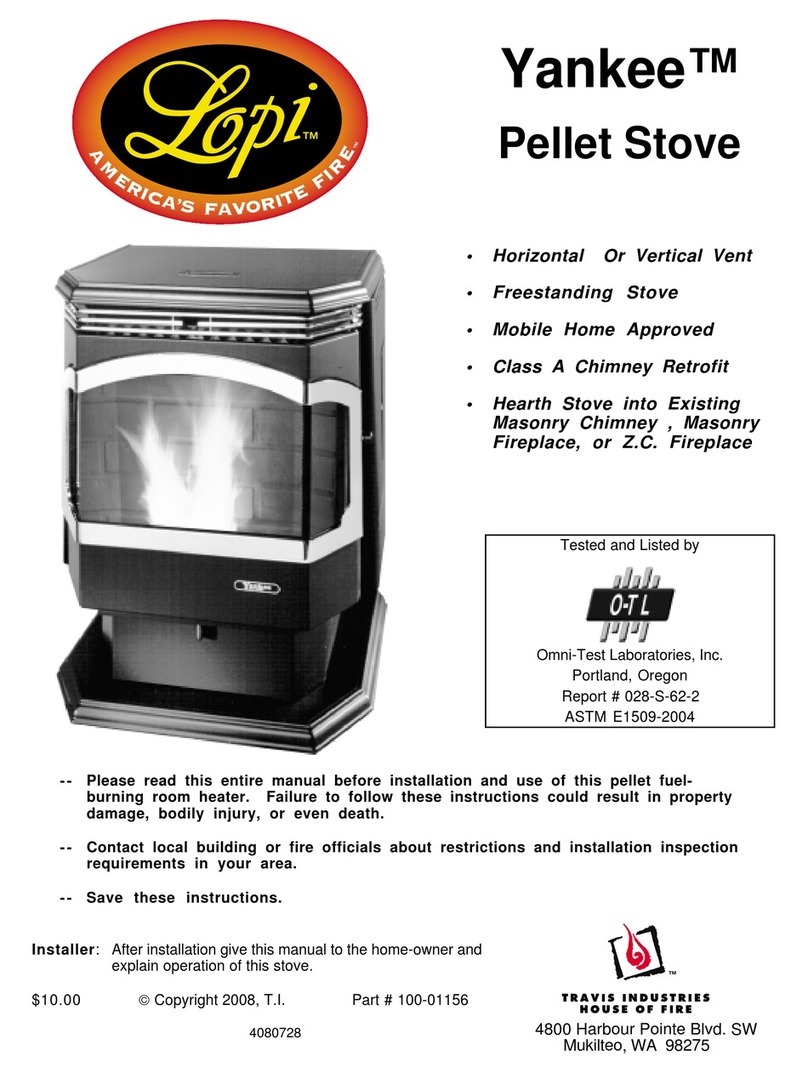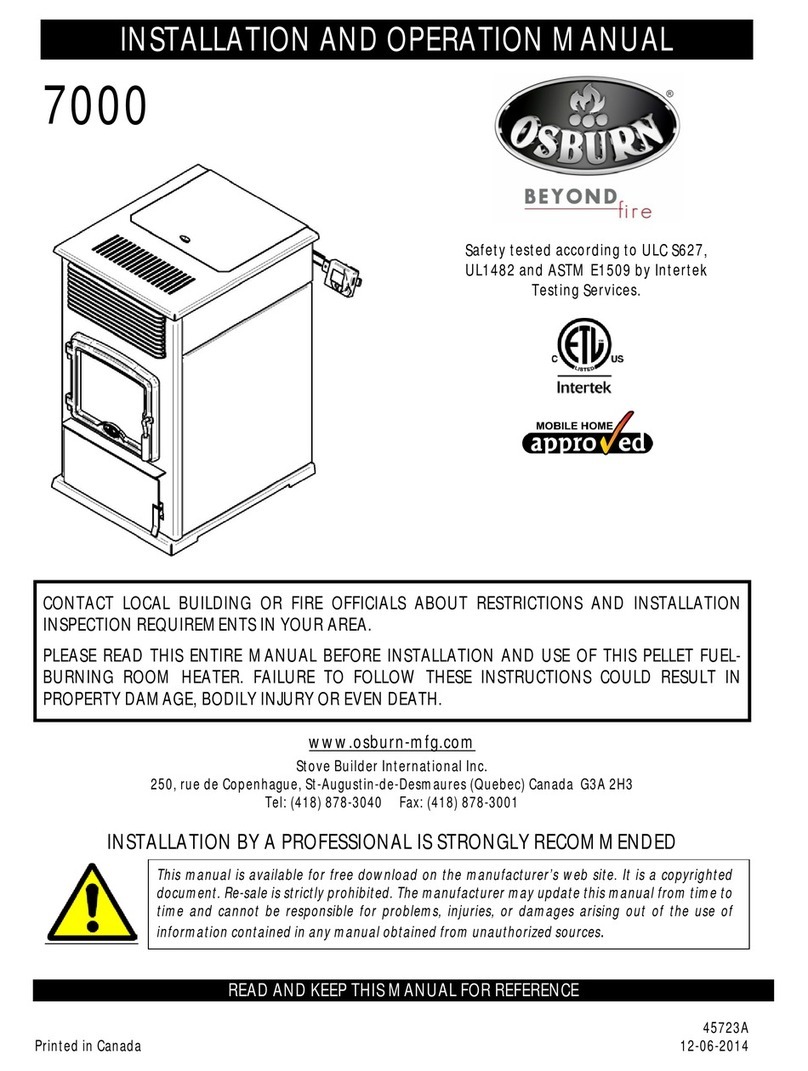Enerzone EUROZONE User manual

45407A
Printed in Canada 18-11-2011
MODEL EUROZONE
OWNER’S MANUAL
Warning: If your appliance is not properly installed, a house fire may result. For your safety, follow the
installation directions. Contact local building or fire officials about restrictions and installation inspection
requirements in your area.
Please read this entire manual before installation and use of this pellet fuel-burning room heater. Failure
to follow these instructions could result in property damage, bodily injury, or even death.
Save these instructions.
Some surfaces become hot at higher feeding rates. To prevent potential burns, avoid contact with those
areas.
This heating unit must serve as a supplementary heat source. An alternative heat source should be
available in the home if needed. The manufacturer cannot be responsible for additional heating costs
associated with the use of an alternative heat source.
It is highly recommended that the user buys this product from a retailer who can provide installation and
maintenance advices.
Professional installation is highly recommended
Manufactured by:
STOVEBUILDERINTERNATIONALINC.
250,deCopenhague,Saint‐Augustin‐de‐Desmaures(Quebec),CanadaG3A2H3
Tel:(418)878‐3040Fax:(418)878‐3001
This manual is available for free download on the manufacturer’s web site. It is a copyrighted
document. Re-sale is strictly prohibited. The manufacturer may update this manual from time to
time and cannot be responsible for problems, injuries, or damages arising out of the use of
information contained in any manual obtained from unauthorized sources.

2
INTRODUCTION
Thank you for purchasing the EUROZONE pellet stove. You are now prepared to burn wood in the
most efficient, convenient way possible. To achieve the safest, most efficient and most enjoyable
performance from your stove, you must do three things: 1) Install it properly; 2) Operate it correctly;
and 3) Maintain it regularly. The purpose of this manual is to help you do all three.
PLEASE read this entire manual before installation and use of this pellet fuel-burning room
heater. Failure to follow these instructions could result in property damage, bodily injury or
even death.
Keep this manual handy for future reference.
Your EUROZONE has been independently tested to ASTM E1509-04 Standard Specification for room
heaters, pellet fuel burning type 1, as well as UL 1482-1998 and ULC 2627-00 Standards for solid fuel
room heaters. This pellet stove, when installed, must be electrically grounded in accordance with local
codes, or in the absence of local codes, with the National Electrical Code, ANSI/NFPA 70 and CSA-
C22.1.
Emissions have been measured according to the EPA and CSA B415.1 Standards and their average
is 1.8 g/h.
We recommend that our pellet hearth products be installed and serviced by professionals who are
certified in the United States by NFI (National Fireplace Institute®) or in Canada by WETT (Wood
Energy Technical Training) or in Quebec by APC (Association des Professionnels du Chauffage).
This appliance is designed for use with pelletized wood only. Do not burn coal of any type in this
appliance. It is designed for residential installation according to current national and local building
codes as a freestanding room heater. It is also approved as a mobile home heater which is designed
for connection to an outside combustion air source.
The stove will not operate using natural draft or without a power source for the blowers and fuel feed
system.
This stove is designed to provide the optimum proportions of fuel and air to the fire in order to burn
free of smoke and soot. Any blockage of the air supply to or from the stove will seriously degrade its
performance and will be evidenced by a smoking exhaust and a sooting window. For best operation,
the ash content of the pellet fuel should be less than 1% and the calorific value approximately 8,200
BTU/LB. Avoid burning high ash content fuels because this will rapidly fill up the burn pot and
eventually cut off the combustion air supply.
The EUROZONE should not be used for commercial or industrial applications since operational
control is often not well managed in these settings
CAUTION: THE INFORMATION GIVEN ON THE CERTIFICATION LABEL AFFIXED TO THE APPLIANCE ALWAYS
OVERRIDES THE INFORMATION PUBLISHED,IN ANY OTHER MEDIA (OWNER’S MANUAL,CATALOGUES,
FLYERS,MAGAZINES AND/OR WEB SITES).

3
SAFETY PRECAUTIONS
Do not operate your stove if you
smell smoke coming from it. Turn it off,
monitor it, and call your dealer. DO NOT
UNPLUG IT
Keep foreign objects out of the hopper.
Never use gasoline, gasoline-type
lantern fuel, kerosene, charcoal lighter fluid, or
similar liquids to start or “freshen up” a fire in
this stove. Keep all such liquids well away from
the stove while in use.
Do not throw this manual away. This
manual has important operating and maintenance
instructions that you will need at a later time.
Always follow the instructions in this manual.
Never block free airflow through the
open vents of the stove.
Do not place clothing or other
flammable items on or near the stove.
Never try to repair or replace any
part of the stove unless instructions are given
in this manual. All other work should be done
by a trained technician.
The viewing door must be closed and
latched during operation.
The stove will not operate during a
power outage. If an outage does occur, check
the stove for smoke spillage and open a
window if any smoke spills into the room.
Do not operate the stove if the flame
becomes dark and sooty or if the burnpot overfills
with pellets. Turn the stove off, inspect it, and call
your dealer.
Disconnect the power cord before
performing any maintenance or repairs on the
stove.
NOTE: Turning the stove “off” does not
disconnect all power from the stove.
Do not touch the hot surfaces of the
heater. Educate all children of the danger of a
high temperature stove. Young children should be
supervised when they are in the same room as
the stove.
Do not unplug the stove if you
suspect a malfunction. Turn the stove off,
inspect it, and call your dealer.
High ambient temperature in summer
time may cause the heat sensors on the stove to
activate the blowers, disconnect the stove when
not used for extended periods.
Contact your local building officials to
obtain a permit and information on any
installation restrictions or inspection
requirements in your area. Notify your
insurance company.
The exhaust system must be
completely airtight and properly installed. All vent
connector joints must be sealed and fastened in
accordance with the pellet pipe manufacturer's
instructions to ensure consistent performance and
avoid smoke and ash spillage.
This unit must be properly installed to
prevent the possibility of a house fire. The
instructions must be strictly adhered to. Do not
use makeshift methods or compromise in the
installation.
Your stove requires maintenance and
cleaning. Failure to maintain your stove may lead
to smoke spillage in your home.
Allow the stove to cool before
carrying out any maintenance or cleaning.
Ashes must be disposed or stored in a metal
container with a tight lid and placed on a non
combustible surface well away from the home
structure.
This stove is designed and approved for
pelletized wood fuel only. Any other type of fuel
burned in this heater will void the warranty.
This stove must be connected to a
standard 120 V., 60 Hz grounded electrical
outlet. Do not use an adapter plug or sever the
grounding plug. Do not route the electrical cord
underneath, in front of, or over the stove.
When installed in a mobile home, the
stove must be bolted to the floor, have outside air,
and NOT BE INSTALLED IN A BEDROOM (Per
H.U.D. requirements). Check with local building
officials.
The exhaust system should be
checked, at least twice a year for any build up
of soot or creosote.
Stove Builder International Inc.
grants no warranty, implied or stated, for the
installation or maintenance of your stove, and
assumes no responsibility of any
consequential damage(s).

4
TABLE OF CONTENTS
INTRODUCTION.....................................................................................................................................................................1
SAFETY PRECAUTIONS.......................................................................................................................................................3
TABLE OF CONTENTS..........................................................................................................................................................4
INSTALLATION......................................................................................................................................................................6
EUROZONE FREESTANDING PELLET STOVE............................................................................................6
PREPARATION..................................................................................................................................................6
CLEARANCES ...................................................................................................................................................6
COMBUSTION AIR SUPPLY ...........................................................................................................................7
WHEN OUTSIDE AIR IS NOT USED ..............................................................................................................7
VENTING............................................................................................................................................................7
ACCESS PANELS ..............................................................................................................................................8
FILTERS INSTALLATION AND CLEANING.................................................................................................8
EQUIVALENT VENT LENGHT (EVL)............................................................................................................9
INSTALLATION CONFIGURATIONS ............................................................................................................9
A. HORIZONTALLY THROUGH WALL.....................................................................................................9
B. VERTICALLY WITH NEW CHIMNEY SYSTEM................................................................................10
C. VERTICALLY INTO EXISTING CHIMNEY SYSTEM .......................................................................10
VERTICALLY INTO EXISTING MASONRY FIREPLACE .....................................................................11
INSTALLATION THROUGH SIDE OF MASONRY CHIMNEY .............................................................11
DOOR OVERLAY INSTALLATION..............................................................................................................12
LEVELING........................................................................................................................................................12
OPERATION.........................................................................................................................................................................13
PROPER FUEL..................................................................................................................................................13
PRE-START-UP CHECK .................................................................................................................................13
BUILDING A FIRE...........................................................................................................................................13
LIGHTING PROCEDURE................................................................................................................................13
UNIT CONTROLS............................................................................................................................................14
MODE BUTTON...........................................................................................................................................14
FUEL FEED SWITCH ..................................................................................................................................14
BUTTON FOR AUTHORIZED TECHNICIANS ........................................................................................14
HEAT LEVEL ...............................................................................................................................................14
RESET ...........................................................................................................................................................14
OPENING DOOR..............................................................................................................................................14
CONVECTION BLOWERS (ROOM AIR FANS)...........................................................................................14
COMBEXtm........................................................................................................................................................15
IF THE STOVE RUNS OUT OF PELLETS.....................................................................................................15
REFUELING .....................................................................................................................................................15
SHUTDOWN PROCEDURE............................................................................................................................16
SAFETY FEATURES .......................................................................................................................................16
DAMPER OPERATION ...................................................................................................................................16
OPERATING THE STOVE USING A THERMOSTAT .................................................................................17
THERMOSTAT INSTALLATION...................................................................................................................17
MODES..............................................................................................................................................................17
OPERATING SAFETY PRECAUTIONS ..............................................................................................................................19
MAINTENANCE....................................................................................................................................................................20
ASH REMOVAL...............................................................................................................................................20
ASH DISPOSAL................................................................................................................................................20
VACCUM USE..................................................................................................................................................21
CLEANING .......................................................................................................................................................21

5
BLOWERS AND PRESSURE SWITCH PROBE............................................................................................22
CHIMNEY CLEANING....................................................................................................................................22
RECOMMENDED MAINTENANCE SCHEDULE........................................................................................23
REMOVAL AND REPLACEMENT OF DOOR GLASS................................................................................23
TROUBLESHOOTING..........................................................................................................................................................24
STOVE SHUTS OFF AND SHOWS WARNING CODE “P”.........................................................................24
STOVE SHUTS OFF AND SHOWS WARNING CODE “E”.........................................................................25
STOVE FEEDS PELLETS, BUT WILL NOT IGNITE AND SHOWS WARNING CODE “L” ...................26
STOVE FEEDS PELLETS, BUT WILL NOT IGNITE AND SHOWS WARNING CODE “I”.....................26
STOVE STOPS FEEDING PELLETS AND SHOWS WARNING CODE “O”.............................................26
STOVE STOPS FEEDING PELLETS AND SHOWS WARNING CODE “H”.............................................27
STOVE STOPS FEEDING PELLETS AND SHOWS WARNING CODE “d”..............................................27
SMOKE SMELL COMING BACK INTO THE HOME..................................................................................28
AUGER MOTOR STOPS FEEDING PELLETS AND COMES BACK ON ..................................................28
GLASS SOOTS UP VERY FAST....................................................................................................................28
FLAME IS LAZY, DARK, AND HAS BLACK TIPS.....................................................................................28
AFTER STOVE HAS BEEN ON FOR A WHILE, THE BURNPOT OVERFILLS .......................................28
WARNING CODES ..........................................................................................................................................29
SMOKE SMELL OR SOOT BUILD-UP..........................................................................................................29
ELECTRICAL DIAGRAM ..................................................................................................................................................... 30
ELECTRIC SHOCK..........................................................................................................................................30
REPLACEMENT PARTS......................................................................................................................................................31
APPENDIX A.........................................................................................................................................................................32
APPENDIX B.........................................................................................................................................................................33
APPENDIX C – PUMP CONNECTION.................................................................................................................................34
ENERZONE LIMITED LIFETIME WARRANTY ...................................................................................................................35
REGISTER YOU WARRANTY ONLINE
To receive full warranty coverage, you will need to show evidence
of the date you purchased your unit. Keep your sales invoice.
We also recommend that you register your warranty online at
http://enerzone-intl.com/warranty-registration.aspx
Registering your warranty online will help us track rapidly the
information we need on your unit.

6
INSTALLATION
EUROZONE FREESTANDING PELLET STOVE
Width: 25”
Height: 34¾”
Depth: 25¼”
Weight: 320 lbs.
Flue size: 3” or 4”
Hopper Capacity: Up to 80 lbs.
(This can vary slightly depending on pellet size, length, and diameter)
EPA status: exempt
Burn rate: 1.3 lbs to 4.1 lbs. per hour
BTU range: 8,200 to 35000
Electrical consumption: 3.5 Amps lighting cycle
2.5 Amps. continuous duty
Control board fuses: Main: 7.5A-250V fastblow
Igniter: 5A-250V fastblow
Electrical requirement: 120VAC 15A
Approved installations: mobile home, conventional
PREPARATION
Factory packaging must be removed, and some minor assembly work is
required prior to installation:
The door overlay must be installed on the door frame;
The black knob must be attached to the heat exchanger rod;
Filters may be inserted between the finger guards and the
convection blowers (see “filters assembly” section).
CLEARANCES
The EUROZONE has been tested and listed for installation in regular and
mobile homes.(refer figure 1 & 2)
FLOOR PROTECTION:In the USA, the unit must be installed on a non-
combustible floor pad extending at least 6 inches (155 mm) in front of the
door opening and at least 6 inches (155 mm) on each side of the door
opening. In Canada, the unit must be installed on a noncombustible floor
pad extending at least 18 inches (460 mm) in front of the door opening and
at least 8 inches (205 mm) at the back and on each side of the unit. The
floor pad must have a thickness of at least 0.015'' (0.38mm). NOTE:
ceramic tile, or any tile, must be laid on a continuous non combustible
sheet to prevent the possibility of embers falling through to the combustible
floor if cracks or separation should occur in the finished surface.
Clearances are measured from the sides, back and face (door opening) or
stove body (refer to fig. 3).
DO NOT USE MAKESHIFT MATERIALS OR COMPROMISES IN THE
INSTALLATION OF THIS UNIT.
INSTALL VENT WITH CLEARANCES SPECIFIED BY THE VENT
MANUFACTURER.
This heating unit must serve as a supplementary heat source. An alternative heat source
should be available in the home if needed. The manufacturer cannot be responsible for
additional heating costs associated with the use of an alternative heat source.
It is highly recommended that the user buys this product from a retailer who can provide
installation and maintenance advices.
Figure 1
Back wall installation
Ouverture
deporte
Figure 2 Figure 3
Corner installation Floor protection
CLEARANCES TO COMBUSTIBLES
CANADA USA
A 2’’ (55 mm) 2’’ (55 mm)
B 6’’ (155 mm) 6’’ (155 mm)
C 2’’ (55 mm) 2’’ (55 mm)
D 3’’ (80 mm) 3’’ (80 mm)
FLOOR PROTECTION
CANADA USA
E 18’’ (460 mm) 6’’ (155 mm)
F N/A (USA only) 6’’ (155 mm)
G 8’’ (205 mm) N/A (Canada only)
H 8’’ (205 mm) N/A (Canada only)
We recommend leaving 24’’ on each sides of the appliance in order to
facilitate access for maintenance.

7
COMBUSTION AIR SUPPLY
For a mobile home installation the stove must be connected to an outside
source of combustion air. A 3” inside diameter metallic pipe, either flexible
or rigid, may be attached to the inlet at the stove’s rear (refer to figures 4, 5
& 6). A rodent guard (minimum 1/4” wire mesh) must be used at the
terminus (refer to figure 5). All connections must be secured and airtight by
either using the appropriately sized hose clamp and/or UL-181-AP foil tape.
For mobile home installations only: combustion air supply conduit may
not exceed 10 feet.
Sources of Outside Combustion Air
A hole in the wall behind the stove.(Figure 5)
A hole in floor near stove rear terminating only in a ventilated
crawl space.(Figure 6)
WHEN OUTSIDE AIR IS NOT USED
If outside air is not used, it is important that combustion air be easily
available to the air inlet. A closable outside air register can be used in
tightly insulated homes.
VENTING
The EUROZONE is certified for use with Vent type UL-103 or ULC S629M
and Chimney type UL-641 or ULC S609, 3” or 4” diameter in size. This unit
can be vented in an existing chimney with the addition of a liner if the
chimney is more than 4” in diameter. Class “A” chimney is not required.
Refer to the instructions provided by the vent or chimney manufacturer,
especially when passing through a wall, ceiling or roof.
Your venting system should have at least one foot of vertical rise for
each foot of horizontal run. The total vertical rise should never be
less than 3 feet (see Appendix A).
This is a pressurized exhaust system. All vent connector joints must be
sealed and fastened in accordance with the pellet pipe manufacturer's
instructions to ensure consistent performance and avoid smoke and ash
spillage.
DO NOT CONNECT THIS UNIT TO A CHIMNEY FLUE SERVING
ANOTHER APPLIANCE.
DO NOT INSTALL A FLUE DAMPER IN THE VENTING SYSTEM OF
THIS UNIT.
INSTALL VENT AT CLEARANCES SPECIFIED BY THE VENT
MANUFACTURER.
WARNING: DO NOT INSTALL IN BEDROOM
CAUTION: THE STRUCTURAL INTEGRITY OF THE MANUFACTURED
HOME FLOOR, WALL, AND CEILING/ROOF MUST BE MAINTAINED
Figure 4
Rear view
Figure 5
Fresh air supply
Figure 6
Ventilated crawl space

8
ACCESS PANELS
Figure 7
Access panel
1- The stove has two access panels
located on each side in order to
access the unit’s various
components. In order to open the
panels, simply pull on the lever
located underneath the top access
panel.
FILTERS INSTALLATION AND CLEANING
The two filters for your convection blowers are supplied with the owner’s manual. Although the filters are not mandatory, they are useful to prevent dust
from being dispersed into the room where the stove is located. If you install the filters, please make sure that they are cleaned on a regular basis as per
our recommended maintenance schedule. This is particularly critical if you have animals in your house, such as a dog or a cat. Filters that are not
cleaned can clog up and cause your stove to overheat. You may also damage or burn the convection blowers. In order to install the filters, simply insert
them in the slot just above the blower’s finger guard. To clean the filters, use a vacuum or remove the filters and rinse them with hot water.
ACCESS PANEL
DOOR LEVER

9
EQUIVALENT VENT LENGHT (EVL)
The longer the run of pipe in your installation, the more restriction there is
in the system. Therefore, larger diameter pipe should be used for longer
runs.
Use 4” pipe if you have more than 15 feet of Equivalent Vent Length
(EVL).
Horizontal runs shall not exceed 10 feet of EVL.
To calculate EVL, use the following conversions table:
Qty Type of pipe EVL equivalent(ft)
1 90° elbow or “T” 5
1 45° elbow 3
1 ft Horizontal pipe run 1
1 ft Vertical pipe run 0.5
NOTE: At altitudes above 3,000 feet, we suggest the use of 4” diameter
vent at an EVL of 7 feet or more.
Here is an example on how to calculate the EVL of your installation. (See
Figure 15)
(3 x 4’ of vertical length = 12’ x 0.5 = 6 EVL) + (1 x elbow or "T" = 5 EVL) +
(2 x 1’ of horizontal length = 2 EVL)
Total EVL = (6 + 5 +2) = 13. So 3” diameter vent is allowed
Note: Do not count the outside termination (goose neck) in the EVL
calculation.
INSTALLATION CONFIGURATIONS
A. HORIZONTALLY THROUGH WALL (refer to figure 14, 15, or 17)
NOTE: Follow Vent chimney manufacturer’s instructions.
1. Position stove, adhering to clearances shown in Figures 1 & 2.
2. Determine position of hole in wall; directly behind stove exhaust vent
(refer to figure 4).
3. Always maintain 3” clearance from combustible materials.
4. Install Vent wall thimble per Vent manufacturer’s instructions.
5. Attach enough piping to penetrate and extend at least 6 inches
beyond the exterior wall. There should always be at least one foot of
vertical rise for each foot of horizontal run (see Appendix A). At least
3 feet of vertical rise are needed in all cases. A longer vertical rise will
favour a better exhaust.
6. To reduce the risk of smoke spillage, never terminate with a horizontal
run. If your system terminates with a horizontal run, add at least 3 feet
of vertical rise (see Appendix A).
7. Attach cap and seal outside wall thimbles with non-hardening
waterproof mastic.
Figure 14
Venting through wall
Figure 15
Venting trough wall
Termination should not be located so that hot exhaust
gases can ignite trees, shrubs, or grasses or be a
hazard to children. Exhaust gases can reach
temperatures of 500ºF and cause serious burns if
touched.
Locate terminations: A) not less than 3 feet above any
forced air inlet located within 10 feet; B) not less than 4
feet below or horizontally from, or one foot above, any
door, window or gravity air inlet into any building; C) not
less than two feet from an adjacent building and not less
than 7 feet above grade when located adjacent to a
public walkway. Mobile home installations must use a
spark arrester. Other restrictions may apply, such as the
need to maintain a minimum distance to a gas meter.
US and Canadian Standards may vary.
Consult the vent manufacturer’s instructions.

10
B. VERTICALLY WITH NEW CHIMNEY SYSTEM (REFER TO FIGURE
16- VENTING THROUGH ROOF)
NOTE: Follow Vent chimney manufacturer’s instructions.
OPTION: To achieve a centered vertical installation, a 45º elbow and a
clean-out tee can be used to offset the pipe from the exhaust outlet to the
rear center of the stove.
OPTION: Install Vent elbow in place of clean-out tee. Locate stove. Drop
plumb bob to center of tee outlet, mark point on ceiling. Install ceiling
support and Vent pipe per Vent manufacturer’s instructions.
1. Always maintain 3” clearance from combustible materials. When
passing through additional floors or ceilings, always install firestop
spacer.
2. After lining up for hole in roof, cut either a round or square hole in roof,
always 3” larger all the way around pipe. Install upper edge and sides
of flashing under roofing materials, nail to the roof along upper edge.
Do not nail lower edge. Seal nail heads with flexible waterproof
sealant.
3. Apply flexible, waterproof sealant where the storm collar meets the
vent. Slide storm collar down until it sits on the flashing. Seal and
install cap. Mobile home installations must use a spark arrester.
C. VERTICALLY INTO EXISTING CHIMNEY SYSTEM
As an alternative, 3” or 4” Vent can be run inside existing chimney to
termination(Figure 18). This is the preferred method.
Follow guidelines for equivalent vent length.
Figure 16
Venting through roof
Figure 17
Basement installation
Figure 18
Venting through existing chimney

11
VERTICALLY INTO EXISTING MASONRY FIREPLACE
NOTE: Follow Vent chimney manufacturer’s instructions.
1. Have the masonry chimney inspected by a qualified chimney
sweep or installer to determine its structural integrity.
2. You must run a pipe from the stove outlet to 18 inches above
the top of the chimney.
3. Install a blanking plate and the chimney pipe, and if used the
outside air pipe, as shown in Figure 20.
4. Attach the DuraVent adapter, a section of pipe and clean out
tee, making sure the clean out tee is centered in the chimney
flue area. Use RTV, metallic tape, and a minimum of three self-
taping screws at all joint connections to ensure a tight seal.
5. Position the stove, adhering to the clearances in Figures 1 & 2.
6. Measure and build chimney top plate. Cut out holes for chimney
pipe, and if used the outside air pipe. Install and seal with
flexible waterproof sealant to prevent water leakage. Install vent
cap.
Figure 19
Venting through masonry
chimney
INSTALLATION THROUGH SIDE OF MASONRY CHIMNEY
NOTE: Follow Vent chimney manufacturer’s instructions.
1. Position the stove, adhering to the clearances in Figures 1 & 2.
Mark the center of the hole where the pipe is to pierce the
masonry chimney.
2. It will be necessary to cut out the masonry around the location
of the pipe center mark. Cut a 4-inch diameter hole for 3-inch
pipe and 5-inch diameter hole for 4-inch pipe.
3. Measure and build chimney top plate. Cut out holes for chimney
pipe, and if used the outside air pipe.
4. Install the tee on the bottom of the vertical pipe system and
lower it down the chimney until the center branch of the tee is
level with the center of the hole in the masonry, as shown in
Figure 20.
5. Install and seal the top plate from step 3 with flexible waterproof
sealant. Slip the storm collar over the pipe, and while holding
the pipe at the proper elevation, affix the collar with a minimum
of three 1/4” stainless steel sheet metal screws. Seal all joints
and seams around the collar.
6. Connect the horizontal pipe by pushing it through the hole in the
masonry and lining it up with the branch in the tee. Push the
pipe into the tee while twisting it to lock it into the tee.
7. If desired, once the horizontal pipe is in place, the space
between the pipe and masonry may be filled with high-
temperature grout.
Install the trim collar. An adjustable pipe length and adapter may be
needed to align and complete the connection to the stove.
Figure 20
Venting through side of
masonry chimney

12
DOOR OVERLAY INSTALLATION
In order to complete the assembly of your Enerzone EUROZONE, you need to install the door overlay.
Figure 36
Door overlay installation
1- Position the overlay on the door
frame and fix it in place from behind
using the 4 screws.
Note: It is not necessary to remove the
glass or any other component to install
the overlay.
LEVELING
Figure 37
Leveling
1- The stove will operate at its best
when properly leveled. If it is not
leveled, adjust one or more of the
leveling bolts to raise or lower the
stove.

13
OPERATION
PROPER FUEL
THIS STOVE IS APPROVED FOR BURNING PELLETIZED WOOD FUEL ONLY! Factory-approved pellets are those 1/4” or 5/16” in diameter and
approximately 1” long. Longer or thicker pellets sometimes bridge the auger flights, which prevents proper pellet feed. Burning wood in forms other
than pellets is not permitted. It will violate the building codes for which the stove has been approved and will void all warranties. This stove
feeds pellets automatically at a preset rate, adding fuel by hand will not increase heat output but may seriously impair the stoves performance by
generating considerable smoke. Do not burn wet pellets. The stove’s performance depends heavily on the quality of your pellet fuel.
Avoid pellet brands that display these characteristics:
a. Excess Fines – “Fines” is a term describing crushed pellets or loose material that looks like sawdust or sand. Pellets can be screened before being
placed in hopper to remove most fines.
b. Binders – Some pellets are produced with materials to hold them together, or “bind” them.
High ash content – Poor quality pellets will often create smoke and dirty glass. They will create a need for more frequent maintenance. You will have to
empty the burn pot and vacuum the entire system more often. Poor quality pellets could damage the auger. ENERZONE cannot accept responsibility for
damage due to poor quality pellets. The pellet ash content should be less than 1%. The pellet grade and ash content should be indicated on the bag by
the pellet manufacturer.
PRE-START-UP CHECK
Remove burn pot, making sure it is clean and none of the air holes are plugged. Clean the firebox, and then reinstall burn pot. Clean door glass if
necessary (a dry cloth or paper towel is usually sufficient). Never use abrasive cleaners on the glass or door. Check fuel in the hopper, and refill if
necessary.
BUILDING A FIRE
Never use a grate or other means of supporting the fuel. Use only the ENERZONE approved burn pot.
NOTE: During the first few fires, your stove will emit an odor and a small amount of fumes as the high temperature paint cures or becomes seasoned to
the metal. Maintaining smaller fires will minimize this. Avoid placing items on stovetop during this period because paint could be affected. Make sure the
room is well-ventilated. Open windows. Odors and fumes released during this process are unpleasant but they are not toxic.
LIGHTING PROCEDURE
a. Fill hopper and clean burn pot.
b. Press To select the thermostat mode, press . It will blink every 5 seconds to indicate the mode as been selected. After 2
minutes, when the display turns itself off, the thermostat icon will be displayed at 50% of is brightness.
c. If the flame is too low in the burn or the stove have difficulty to light. Adjust the air supply toward the minimum setting for start-up. In some
situations, it may be necessary to have the damper completely closed for ignition to take place. After there is a flame, the damper can then be
adjusted for the desired feed setting. If that doesn’t fix, verify if the burn pot gaskets are in place and in good condition.
d. Adjust feed rate to desired setting by pressing the desired level on the gradient 1 to 6.
If the fire doesn’t start within 30 minutes, refer to troubleshooting section.
DISPLAY BOARD

14
UNIT CONTROLS
The blowers and automatic fuel supply are controlled from the panel on the EUROZONE. The control panel functions are as follows:
Note:
1- To display the available functions, just touch the control board at any place
2- Select the desired function
*The display will turn itself off after 2 minutes.
MODE BUTTON
When the button is pressed, the stove will automatically ignite. The heat level must be selected manually to adjust the stove’s heat output
to the desired level. If the thermostat mode is selected, the stove will automatically modulate between the lowest heat level and the heat level
selected to keep the room temperature at the thermostat’s setting. If the set room temperature is achieved while the stove has been running at the
lowest heat level for more than 45 minutes, the unit will automatically shut off and will start another ignition cycle only when the thermostat calls for
heat again(stove has to cool down completely before igniting again). No fire starter is necessary to ignite the unit. The auger will feed fuel for 4
minutes and the electronic igniter will stay on for 10 minutes. If the unit doesn’t ignite within 15 minutes, the stove will wait for 5 minutes and will
start a second ignition cycle. If ignition fails a second time, a warning message will appear on control panel.
The Heat Level may be selected during the ignition cycle and can be modified in heating mode. However, the unit will only feed fuel at the desired
heat level setting when the heat sensor located into the stove receives a signal indicating that the unit has ignited. This may take anywhere
between 10 and 15 minutes.
FUEL FEED SWITCH
By activating this function, the stove will feed for 1 minute and the display will blink. You can stop the distribution by touching the sign a second
time or by starting the stove.
CAUTION: THIS FUNCTION CAN ONLY BE OPERATED WHEN THE STOVE IS IN “OFF” POSITION. THE FUEL FEED SWITCH IS USED TO
PRIME THE AUGER WHEN THE AUGER IS EMPTY.
BUTTON FOR
AUTHORIZED
TECHNICIANS
This button is designed for authorized technicians for troubleshooting purposes. No functionality of operation is related to this button.The convection
blowers speed varies according to the fuel feed rate.
HEAT LEVEL
By pressing the gradient, you can set the pellet feed rate and hence the heat output of your stove. The levels of heat output will change and each
gradient will indicate the level from 1 to 6.
RESET
The reset icon is used to clear any warning on the control before restarting your stove. This icon is only visible when you have a warning code on
the display.
OPENING DOOR
The door should be opened only for maintenance purposes.
CONVECTION BLOWERS (ROOM AIR FANS)
Upon starting your stove, the convection blowers will not come on until the stove’s heat exchanger has warmed up. This usually takes about 10 to 15
minutes from start-up. Speed will vary with the selected feed rate, except if the noise reducer mode has been activated.

15
COMBEXtm
Your stove uses a unique patented technology called COMBEX. As opposed to most other pellet stoves, which use only an
exhaust blower, your EUROZONE uses a motor on which are mounted two housings with impeller blades. One housing serves
for combustion, and the other for exhaust. This is why we refer to the combustion/exhaust blower throughout this manual.
The COMBEX system balances combustion air and uptake to provide clean, worry-free combustion which is less dependent
on the leak-tightness of the device and the quality of the combustible.
IF THE STOVE RUNS OUT OF PELLETS
The fire goes out and the auger motor and blowers will run until the stove cools down. This will take a few minutes.
After the stove’s components stop running, a warning message will appear .
To restart, press , refill the hopper , and press until pellets begin to fall into the burn pot. Press to start the unit.
COMBURANT AIR DAMPER CONTROL
The damper control on the stove is located on the right hand side panel. This control is used to adjust the air intake manually depending on the type of
installation and different brands of pellets used. It allows you to improve the efficiency of your stove. Providing correct combustion air will reduce the
frequency of cleaning your door glass and reduce creosote build-up of creosote inside your stove and chimney.
You should adjust the damper based on the fire’s appearance. A low, reddish, dirty fire can be improved by increasing the air supply using the damper
rod. A “blow torch” fire can be improved by reducing the air supply.
Through trial and error, you will find the best setting. Consult your dealer if you need help.
REFUELING
We recommend that you do not let the hopper drop below 1/4 full. If the hopper lid stays open more than 3 minutes, a warning will appear. To
restart, press icon, and then press .
KEEP HOPPER LID CLOSED AT ALL TIMES EXCEPT WHEN REFILLING. THE HOPPER MAY BE FILLED WHILE THE STOVE IS OPERATING.
DO NOT OVERFILL HOPPER. DO NOT TOUCH THE UNIT WITH THE PELLET BAG. HOT SURFACE MAY MELT THE BAG.

16
SHUTDOWN PROCEDURE
Turning your ENERZONE stove off is a matter of pressing on the control panel. The blowers will continue to operate until internal firebox
temperatures have fallen to a preset level. The stove cannot restart before it has completely shut down.
SAFETY FEATURES
a. Your stove is equipped with a manual reset high temperature switch (also called heat sensor or heat switch). The switch has a reset button on
its backside. Like a circuit breaker, once tripped, the reset button will have to be pushed before you can restart the stove. The high
temperature switch protects the stove against overheating due to of an evacuation problem, a control board problem, a blower problem, or any
other problem causing the unit to overheat. The manufacturer recommends that you contact your dealer if this occurs as it may hide a major
problem. A service call may be required.
NOTE: If an overheating situation occurs, the high temperature switch (called the L-250 manual reset) will automatically shut down the auger
motor (fuel feed system) and a warning code will appear.
b. If the combustion blower fails, an air pressure switch will automatically shut down the auger and a warning message will appear. This
safety feature is to prevent the unit from igniting or burning fuel when the combustion/exhaust blower has failed, therefore preventing
combustion fumes from spilling into the room.
c. If the temperature in the auger rises beyond a certain acceptable level, two high temperature switches located under and above auger housing
will stop the fuel feed system and a warning will appear.
CODE BEFORE RESETING TO RESET
H1, H2, H3
OR H4 Heat exchanger and/or exhaust system
is/are clogged. Refer to the owner’s manual
for maintenance procedures. Press simultaneously for 2 seconds and
icons.
*** After 3 attempts, reset is no longer possible, call SBI technical support.
DAMPER OPERATION
Figure 39
Damper operation

17
OPERATING THE STOVE USING A THERMOSTAT
A thermostat will help you maintain a constant house temperature
automatically. A low voltage or 24 Volt thermostat is required. A fixed
wall mount or remote model can be used.
THERMOSTAT INSTALLATION
Unplug the stove from the power outlet.
Connect two thermostat wires to the terminal block located on the
lower right side of the back of the stove. To do so, loosen the two
screws and insert the wires in the terminals. Tighten the two
screws. (See Figure 40)
If you are using a wireless wall thermostat or a hand held
thermostatic remote control, you can locate the receiver behind the
stove’s back panel, on the right side, just below the terminal block.
Most receivers are already equipped with quick-connect terminals.
Simply unplug the PC board wires connected to the back of the
terminal block and connect them directly with the receiver’s
terminals. Location of the thermostat is very important to obtain
the best comfort and efficiency from you EUROZONE. The
thermostat should be mounted 50 inch from the floor on a wall
located 15 to 20 feet from the stove. You should avoid installing
directly in front of the stove to avoid cycling.(See Figure 41)
MODES
THERMOSTATIC MODE
To engage this mode, the thermostat icon must be
pushed upon starting the stove. The heat setting is then selected
using the “Heat Level” selector. When set in thermostatic mode,
the stove will automatically run at the heat level selected until the
set room temperature is reached. When that occurs, the stove will
switch to heat setting #1 (lowest) until the thermostat calls for heat
again. The convection blowers will also slow down to low speed.
When the thermostat calls for heat again, the stove will
automatically switch back to the selected heat level.
N.B.: If the room temperature remains stable and the thermostat
does not call for heat during at least 45 minutes, the stove will shut
down. When the thermostat calls for heat again, the stove will
start an ignition cycle. Once the ignition cycle is completed, the
stove will increase its feed rate to match the heat selected heat
level.
Figure 40
Thermostat terminal
Thermostat terminal

18
N.B.: It is possible to change the setting of your unit such that if the
thermostat does not call for heat after 45 minutes, the unit will remain at
the lowest heat setting (#1) but will not shut down (this is the PILOT ON
mode). The stove will remain at the lowest heat level until the
thermostat calls for heat again. If you prefer that your unit runs
following that logic, you need to change the setting to PILOT ON by the
pressing the following two buttons on the PC Board:
First press , hold it, and then press . Hold the two buttons
for a couple of seconds.
Once you do that, the letters P, I, L, O, T, O, N will appear on the PC
Board to let you know that you are in the “PILOT ON” mode. If you wish
to go back to the default thermostatic mode (i.e. the unit shuts down
after 45 minutes if the thermostat does not call for heat), simply press
the same two buttons again for a couple of seconds. The letters P, I, L,
O, T, A, U, T, O will appear on the PC Board to let you know that you
are in the “PILOT AUTO” mode.
NOTE: When in thermostatic mode:
You should not operate the manual control or play with the
temperature setting.
YOUR THERMOSTAT SHOULD BE INSTALLED BY AN
AUTHORIZED DEALER OR QUALIFIED TECHNICIAN.
Figure 41
Thermostat location

19
OPERATING SAFETY PRECAUTIONS
PLEASE READ THIS!
a. If you notice a smoldering fire (burnpot full but no visible flame) AND a heavy smoke buildup in firebox,
immediately TURN OFF the stove, but DO NOT unplug it. Do not open the door, change the damper setting or
tamper with any controls on the stove. Wait until smoke inside the firebox clears and blowers shut down. Do as
instructed in “PRE-START-UP CHECK” and “LIGHTHING PROCEDURE”, then attempt to restart the fire. If the
problem persists, contact your dealer. Please note that smoke build-up during ignition may occur. Smoke can
accumulate in the firebox for a few seconds just before the igniter is hot enough to fire-up the pellets in the burn pot.
This is normal. As soon there is fire in the burn pot, smoke will disappear.
b. DO NOT STORE OR USE FLAMMABLE LIQUIDS, ESPECIALLY GASOLINE, IN THE VICINITY OF YOUR
ENERZONE STOVE. NEVER USE A GAS OR PROPANE TORCH, GASOLINE, GASOLINE-TYPE LANTERN
FUEL, KEROSENE, CHARCOAL LIGHTER FLUID OR SIMILAR FLUIDS TO START OR “FRESHEN UP” A FIRE
IN THIS HEATER.
c. WARNING: DO NOT OVERFIRE THIS STOVE. This may cause serious damage to your stove and void your
warranty. It also may create a fire hazard in your home. IF ANY EXTERNAL PART OF THE UNIT BEGINS TO
GLOW, YOU ARE OVERFIRING. Immediately press on the control panel. DO NOT UNPLUG YOUR
STOVE. If you leave your house and your stove is not connected to a thermostat or a fresh air supply, do not leave it
at the maximum setting. If the ambient air becomes to hot, the stove may overheat and the thermal protection
on the combustion/exhaust motor may be activated, causing the motor to stop.
d. KEEP ALL HOUSEHOLD COMBUSTIBLE MATERIALS, SUCH AS FURNITURE, DRAPES, TOYS, ETC. AT
LEAST THREE FEET AWAY FROM THE STOVE.
e. Always maintain proper ventilation. It is important that sufficient oxygen be supplied to the fire for optimal combustion.
Modern houses are often so well insulated that it may become necessary to open a window slightly or install an
outside air vent to provide sufficient combustion air.
f. Since heating with solid fuel is potentially hazardous, even with a well built and thoroughly tested stove, it would be
wise to install strategically placed smoke detectors and have a fire extinguisher in a convenient location, near an exit.
g. Do not open the stove door when operating unless necessary. This will create a dirty, inefficient burn and could allow
smoke spillage or sparks to escape.
h. Stove must not be operated by young children or someone unfamiliar with stove’s operation.
i. Do not service or clean this appliance without disconnecting the power cord.
j. Do not abuse the door glass by striking, slamming or similar trauma. Do not operate the stove with the glass removed,
cracked or broken.
k. High ambient temperature in summer time may cause the heat sensors on the stove to activate the blowers,
disconnect the stove when not used for extended periods.

20
MAINTENANCE
FAILURE TO CLEAN AND MAINTAIN THIS UNIT AS INDICATED CAN
RESULT IN POOR PERFORMANCE AND SAFETY HAZARDS. NEVER
CLEAN WHEN HOT.
NOTE: Inspect burn pot periodically to see that holes have not
become plugged. If so, clean thoroughly.
ASH REMOVAL
The EUROZONE stove has an ash drawer located under the firebox. To
remove ashes:
a. Make sure fire is out and the firebox is cool.
b. Open the door and remove the baffle from the firebox. Slide each side
of the baffle toward the center to remove(Figure 46). Close the door.
c. With the door closed, clean heat exchanger tubes by sliding the
cleaning rod back and forth.
(see Cleaning section and Figure 42 & 43) .
d. Open the door and remove the burn pot by grasping it and pulling
straight out. Scrape the burn pot with a scraper if necessary. Make
sure that the burn pot holes are not plugged. Empty ashes from the
burn pot into the ash drawer through the opening at the bottom of the
firebox. Put the burn pot back in place. Make sure it is level and
pushed all the way in. Make sure the burn pot gasket is in place
before putting the burn pot back. Absence of this gasket will cause
ignition problems.
e. Sweep the ashes in the firebox into the ash drawer through the
opening at the bottom of the firebox or vacuum to remove ashes.
WARNING: Make sure ashes are cool to the touch
before using a vacuum. See “VACUUM USE”.
f. Periodically remove and empty the ash drawer (see Figure 44 & 45)
below the ash lip. Dispose of ashes properly.
(See “ASH REMOVAL” above)
g. Put the ash drawer back into place, making sure the ash plug is into
place and maintain a good seal. Air leak will affect the combustion.
ASH DISPOSAL
Ashes should be stored in a metal container with a tight-fitting lid. The
closed container or ashes should be placed on a non-combustible surface
or on the ground, well away from all combustible materials pending final
disposal. If ashes are disposed of by soil burial or otherwise locally
dispersed, they should be retained in the closed container until all cinders
have thoroughly cooled. The ashes can be removed with the ash pan or
with a vacuum cleaner.
Figure 42
Baffle & exhaust access panel
Figure 43
Cleaning rod
Figure 45
Ash drawer
Table of contents
Other Enerzone Pellet Stove manuals
Popular Pellet Stove manuals by other brands
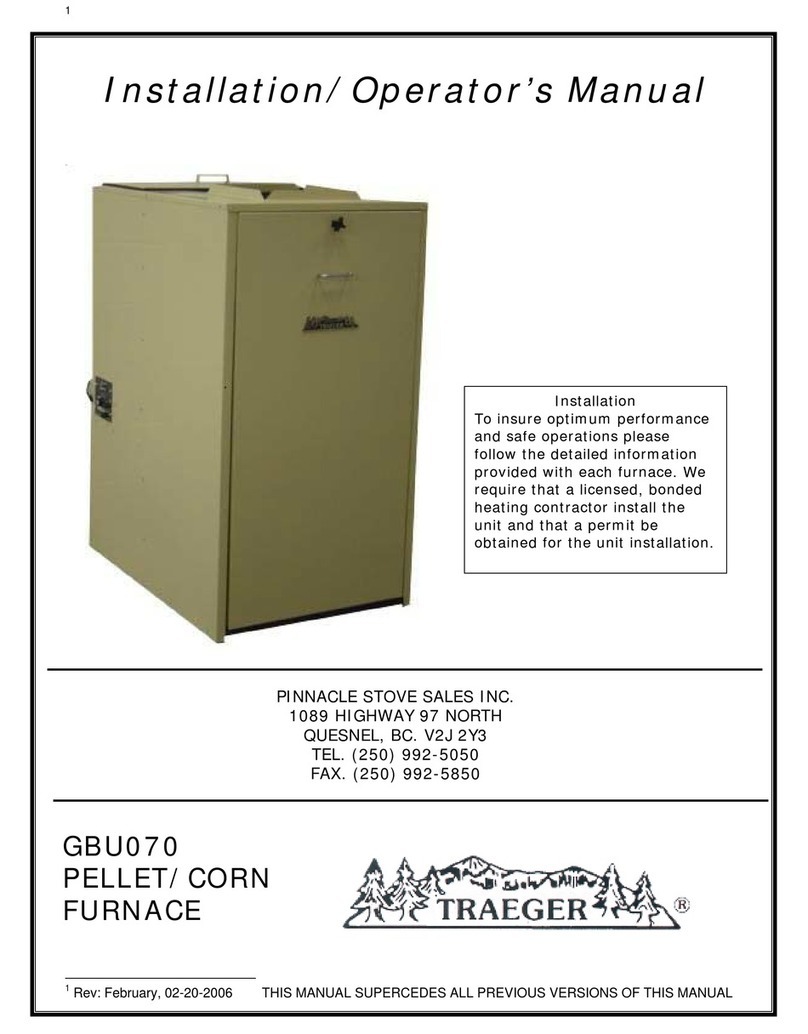
Pinnacle
Pinnacle GBU070 Installation & operator's manual
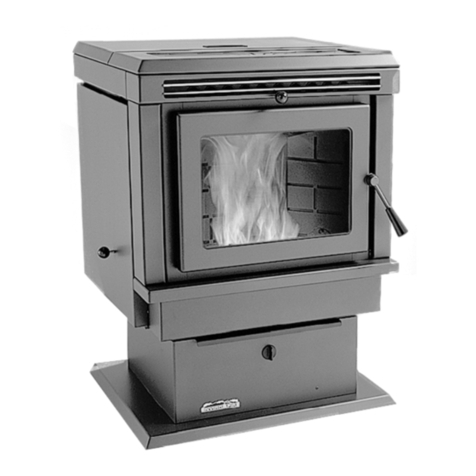
Enviro
Enviro EF2 Service manual

Harman
Harman Advance 1 Installation & operating manual

Ferroli
Ferroli SALERNO PELLET Assembly and exploitation manual
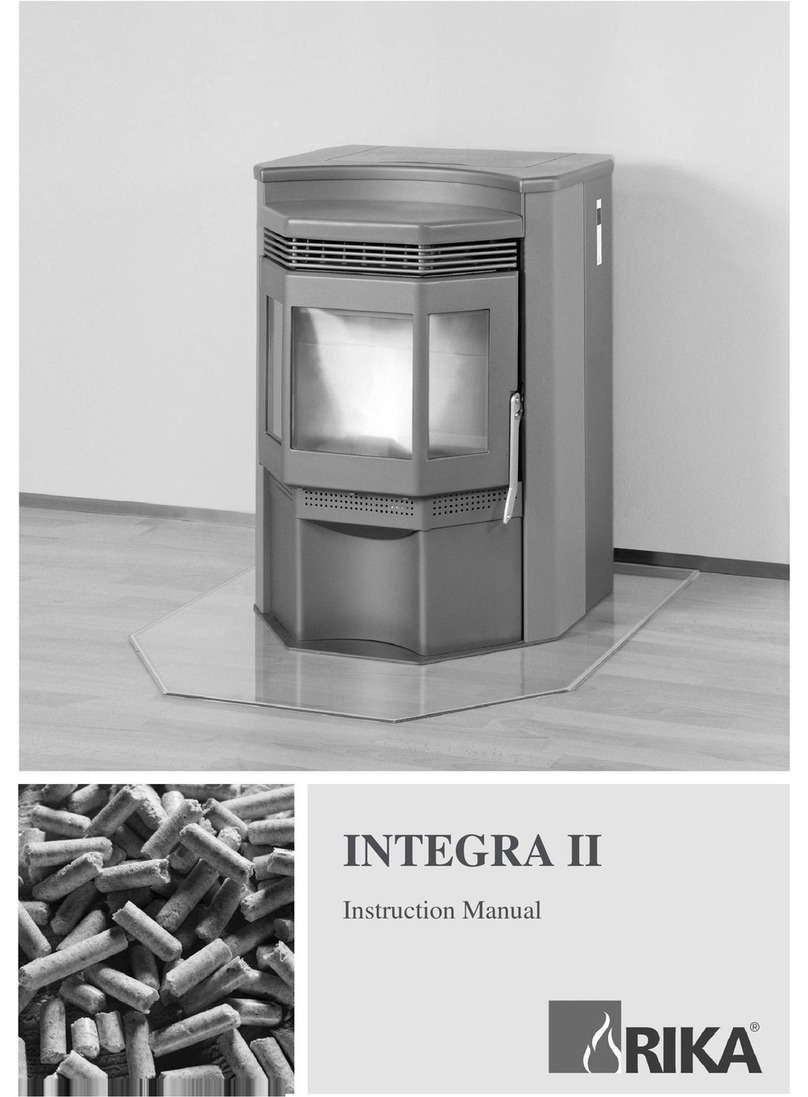
RIKA
RIKA INTEGRA II instruction manual
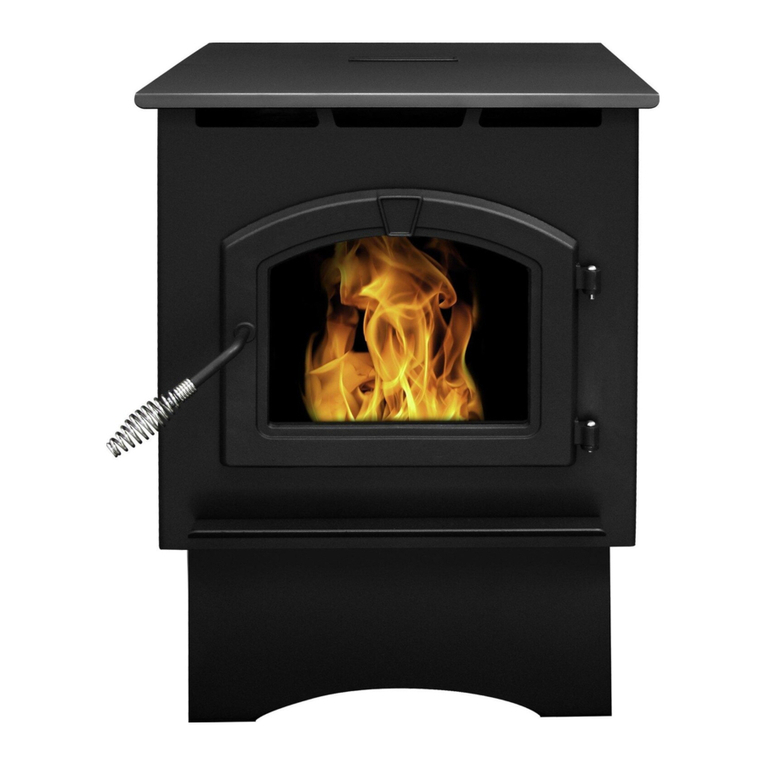
pleasant hearth
pleasant hearth PH35PS Series owner's manual
